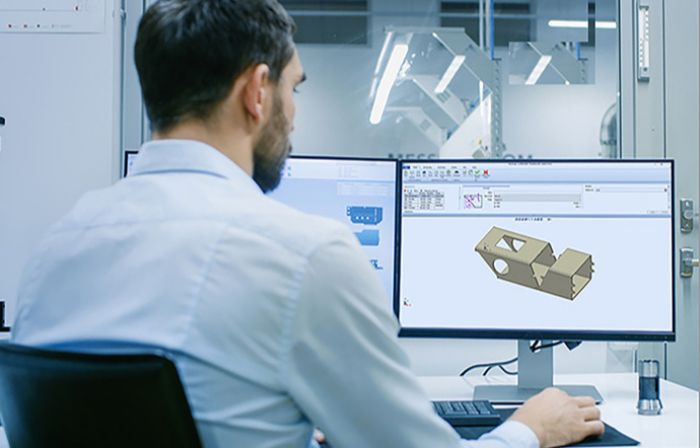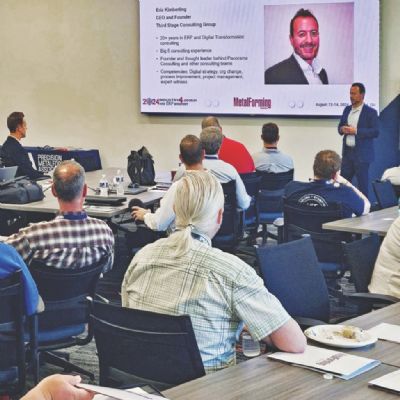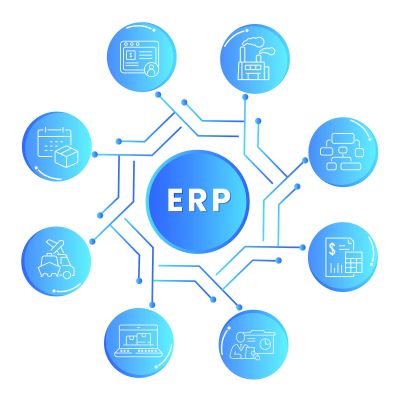“For example,” Chakraborty continues, “a fabricator may enter cut conditions based on parameters such as material type and thickness, and sheet dimensions. Selection of improper cut conditions leads to scrap and rework. To avoid this, map the material—type, thickness, sheet dimensions, etc.—to the CAM system, and see how seamlessly the material can be brought into the manufacturing operation.”
Secondly, Chakraborty advises, define procedures.
“A fabricator has built-in procedures, such as first-article inspection,” he says. “Create the first nest, then look at the part. If everything is fine, then continue. This must be defined. ERP will dictate a first-article-inspection requirement, and other downstream requirements.”
And, track data throughout the manufacturing process.
“To err is human, and machines can err as well,” says Chakraborty, “so manufacturing may still produce scrap.”
The possibility of errors demands tracking of data for analysis.
 “Why did the process generate scrap?” he asks, explaining the need for data gathering. “ERP should have the analytical background to determine that, for example, the process generates scrap on occasion with a particular material. Analysis of data may determine that, for instance, this scrap results from using low-quality material from a particular supplier. ERP provides for the ability to make such analyses.”
“Why did the process generate scrap?” he asks, explaining the need for data gathering. “ERP should have the analytical background to determine that, for example, the process generates scrap on occasion with a particular material. Analysis of data may determine that, for instance, this scrap results from using low-quality material from a particular supplier. ERP provides for the ability to make such analyses.”
Proper routing of instructions, with the CAM system and ERP on the same page, also results in reduced rework and scrap.
“ERP is not the nesting system, nor the CAM system,” Chakraborty explains. “Proper ERP can blend with the CAM system and import CAM reports to properly advise operators. Rework on a press brake operation, for example, may result from bending material upside-down or in the wrong direction. A proper setup allows ERP to bring in proper instructions from the CAM system, and provide the operator and other stakeholders with instructions in an easy-to-follow format.”
Optimize Machine and Job Scheduling
Again, a proper ERP solution oversees the three Ms—machine, manpower and material—as earlier described by Chakraborty. This makes ERP, in concert with other manufacturing-oversight software such as MES, an ideal tool to optimize machine and job scheduling.
“The ERP system knows who is operating what, what shifts they operate on, the lunch hours and break times, and so on,” Chakraborty says. “Let the nesting software, with time and materials data, integrate with the ERP and MES for effective machine and job scheduling.”
For its part, Lantek has its own nesting software that integrates with Lantek ERP and MES, explains Chakraborty. But assuming that the nesting and ERP/MES systems come from different vendors, the integration principle still holds.
“A nesting system outputs data that ERP should be able to read and map against existing inventory,” he explains. “Based on the material availability and the estimated job time, the ERP/MES may provide a recommendation to change the job/machine routing based on estimated job time because the selected laser cutting machine is overbooked. Good ERP/MES provides this visibility. It can tell the programmer, ‘don’t program this job for laser cutting machine A, program it for machine B.’ Effective systems provide visibility into the three Ms to optimize machine and job scheduling. Visibility can occur before or after programming. After means going back and reprogramming, and before allows changes to be made immediately.”
Enables Shop-Floor Continuous Improvement
With data available for the three Ms in an integrated setup, fabricators have in their hands a powerful tool to foster continuous improvement via analysis of that data.
“Combining a system that provides machine data along with data from ERP provides a platform for stakeholders to understand everything that occurs on the shop floor,” Chakraborty says. “That data may show problems with material from a certain supplier, or particular problems on a laser cutting machine. Analyzing the data delivers solutions. Maybe it’s time to switch material suppliers or perform a different type of maintenance on a high-downtime piece of equipment, or reallocate personnel.
“Good ERP/MES, and proper integration with other information areas such as nesting software provides insight to identify bottlenecks and free them,” Chakraborty concludes. “It all starts with visibility into the three Ms.” MF
View Glossary of Metalforming Terms
See also: Lantek Systems Inc.
Technologies: Management







 “It comes down to how visible is your shop floor,” says Anupam Chakraborty, commercial director for Lantek Systems, Inc., describing how effective shop-management software can transform operations, with real shop-floor wins. And, as he explains here, enterprise resource planning (ERP) and manufacturing execution system (MES) software provide a path for operational continuous improvement.
“It comes down to how visible is your shop floor,” says Anupam Chakraborty, commercial director for Lantek Systems, Inc., describing how effective shop-management software can transform operations, with real shop-floor wins. And, as he explains here, enterprise resource planning (ERP) and manufacturing execution system (MES) software provide a path for operational continuous improvement.

